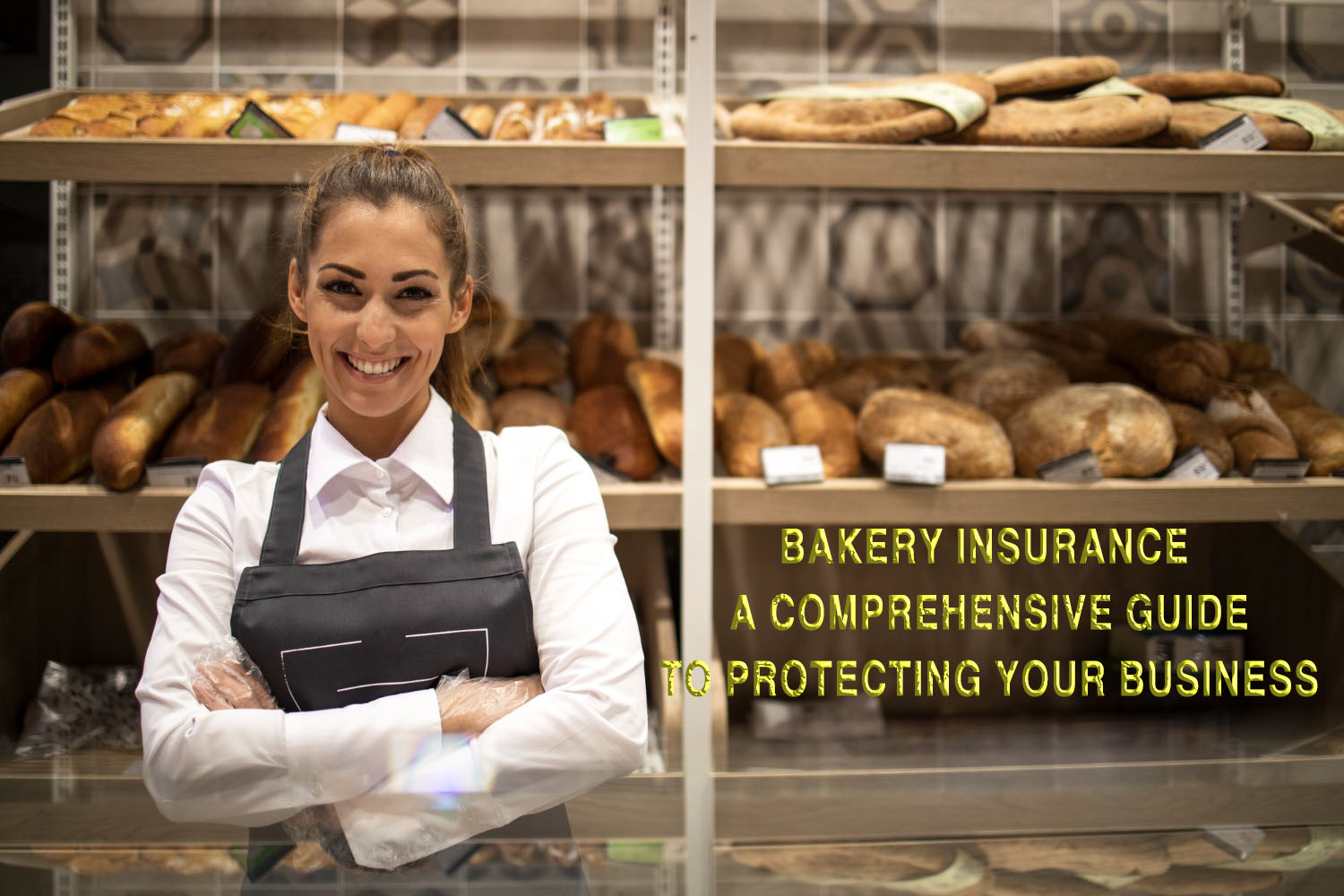Bakery Insurance: A Comprehensive Guide to Protecting Your Business
Running a bakery is a labor of love. From the early morning hours spent kneading dough to seeing customers enjoy your creations, owning a bakery is a rewarding endeavor. However, like any business, bakeries face various risks that can threaten their success. The potential for financial loss is significant from fire and theft to liability claims and employee injuries. That’s where bakery insurance comes in.
Bakery insurance is a specialized type of business insurance designed to protect bakery owners from the unique risks they face. In this comprehensive guide, we’ll explore the different types of bakery insurance available, the risks they cover, and how to choose the right policy for your business. Whether you’re a small home-based bakery or a large commercial operation, understanding bakery insurance is essential to safeguarding your business and ensuring its long-term success.

Chapter 1: Understanding the Liability InsuranceFaced by Bakeries
Before diving into the specifics of bakery insurance, it’s important to understand the risks that bakeries face. These risks can vary depending on the size and scope of your business, but some common risks include:
1.1 Property Damage
Bakeries are filled with expensive equipment, from ovens and mixers to refrigerators and display cases. A fire, flood, or other disaster could result in significant property damage, leading to costly repairs or replacements. Additionally, theft or vandalism could result in the loss of valuable equipment or inventory.
1.2 Liability Claims
Bakeries are public spaces, which means there’s always a risk of customer injuries. Slip-and-fall accidents, foodborne illnesses, or allergic reactions to your products could result in liability claims. If a customer decides to sue your bakery, the legal fees and potential settlements could be financially devastating.
1.3 Employee Injuries
Bakeries often involve manual labor, such as lifting heavy bags of flour or working with hot ovens. This increases the risk of employee injuries, which could result in workers’ compensation claims. Additionally, if an employee is injured on the job, you could be held liable for their medical expenses and lost wages.
1.4 Business Interruption
If your bakery is forced to close temporarily due to a covered event, such as a fire or natural disaster, you could lose significant revenue. Business interruption insurance can help cover lost income and ongoing expenses, such as rent and utilities, while your bakery is closed.
1.5 Product Liability
If a customer becomes ill or injured as a result of consuming your baked goods, you could face a product liability claim. This could include claims related to foodborne illnesses, allergic reactions, or foreign objects found in your products.
1.6 Equipment Breakdown
Bakeries rely heavily on specialized equipment, such as ovens, mixers, and refrigerators. If this equipment breaks down, it could disrupt your operations and result in costly repairs or replacements. Equipment breakdown insurance can help cover these expenses.
1.7 Cyber Liability
In today’s digital age, bakeries are increasingly reliant on technology for operations, such as point-of-sale systems and online ordering. This increases the risk of cyberattacks, such as data breaches or ransomware. Cyber liability insurance can help cover the costs associated with a cyberattack, including legal fees, notification costs, and credit monitoring for affected customers.
Chapter 2: Types of Bakery Insurance Coverage
Now that we’ve covered the risks faced by bakeries, let’s explore the different types of insurance coverage available to protect your business.
2.1 General Liability Insurance
General liability insurance is a foundational coverage that protects your bakery from third-party claims of bodily injury, property damage, and personal injury. This includes claims related to slip-and-fall accidents, foodborne illnesses, and allergic reactions. General liability insurance can help cover legal fees, medical expenses, and settlements or judgments.
2.2 Property Insurance
Property insurance protects your bakery’s physical assets, including your building, equipment, inventory, and furnishings. This coverage can help pay for repairs or replacements if your property is damaged or destroyed by a covered event, such as a fire, flood, or theft. It’s important to ensure that your property insurance policy includes coverage for both your building and its contents.
2.3 Workers’ Compensation Insurance
If you have employees, workers’ compensation insurance is typically required by law. This coverage provides benefits to employees who are injured or become ill as a result of their job. Benefits may include medical expenses, lost wages, and rehabilitation costs. Workers’ compensation insurance also protects your bakery from lawsuits related to workplace injuries.
2.4 Business Interruption Insurance
Business interruption insurance, also known as business income insurance, helps cover lost income and ongoing expenses if your bakery is forced to close temporarily due to a covered event, such as a fire or natural disaster. This coverage can help you pay rent, utilities, and other expenses while your bakery is closed, allowing you to focus on rebuilding and reopening.
2.5 Product Liability Insurance

Product liability insurance protects your bakery from claims related to the products you sell. This includes claims of foodborne illnesses, allergic reactions, or foreign objects found in your baked goods. Product liability insurance can help cover legal fees, medical expenses, and settlements or judgments.
2.6 Equipment Breakdown Insurance
Equipment breakdown insurance, also known as boiler and machinery insurance, covers the cost of repairing or replacing specialized equipment that breaks down due to mechanical or electrical failure. This includes ovens, mixers, refrigerators, and other essential equipment. Equipment breakdown insurance can also cover the cost of lost income if your bakery is unable to operate due to equipment failure.
2.7 Commercial Auto Insurance
If your bakery uses vehicles for deliveries, catering, or other business purposes, commercial auto insurance is essential. This coverage protects your vehicles and drivers in the event of an accident, theft, or other damage. Commercial auto insurance typically includes liability coverage, collision coverage, and comprehensive coverage.
2.8 Cyber Liability Insurance
Cyber liability insurance protects your bakery from the financial impact of a cyberattack, such as a data breach or ransomware. This coverage can help cover the costs of notifying affected customers, providing credit monitoring services, and defending against lawsuits. Cyber liability insurance can also cover the cost of restoring lost data and repairing damaged systems.
2.9 Spoilage Insurance
Bakeries rely on perishable ingredients, such as flour, eggs, and dairy products. If your refrigeration or storage equipment fails, your inventory could spoil, resulting in significant financial loss. Spoilage insurance can help cover the cost of replacing spoiled inventory and any lost income due to the spoilage.
2.10 Umbrella Insurance
Umbrella insurance provides additional liability coverage beyond the limits of your other insurance policies, such as general liability and commercial auto insurance. This coverage can be invaluable if your bakery faces a large liability claim that exceeds the limits of your primary policies. Umbrella insurance can help protect your bakery’s assets and future earnings.
Chapter 3: How to Choose the Right Bakery Insurance Policy
Choosing the right bakery insurance policy can be a daunting task, but it’s essential to ensure that your business is adequately protected. Here are some steps to help you choose the right policy:
3.1 Assess Your Risks
The first step in choosing the right bakery insurance policy is to assess the risks your business faces. Consider the size and scope of your bakery, the types of products you sell, and the number of employees you have. This will help you determine which types of coverage are most important for your business.
3.2 Work with an Experienced Insurance Agent
An experienced insurance agent who specializes in bakery insurance can help you navigate the complexities of business insurance and find the right policy for your needs. They can also help you understand the coverage limits, deductibles, and exclusions of each policy.
3.3 Compare Quotes
It’s important to compare quotes from multiple insurance providers to ensure that you’re getting the best coverage at the most competitive price. Be sure to compare not only the cost of the policy but also the coverage limits, deductibles, and exclusions.
3.4 Review Your Policy Regularly
Your bakery’s insurance needs may change over time as your business grows and evolves. It’s important to review your insurance policy regularly and make adjustments as needed. This may include increasing coverage limits, adding new types of coverage, or switching to a different insurance provider.
3.5 Consider Bundling Policies
Many insurance providers offer discounts for bundling multiple types of coverage, such as general liability, property, and workers’ compensation insurance. Bundling your policies can help you save money while ensuring that your bakery is fully protected.

3.6 Understand the Claims Process
In the event of a claim, it’s important to understand the claims process and how to file a claim with your insurance provider. Be sure to keep detailed records of any incidents, including photos, witness statements, and police reports. This will help ensure that your claim is processed quickly and efficiently.
Chapter 4: Tips for Reducing Insurance Costs

While bakery insurance is essential, it can also be a significant expense. Here are some tips for reducing your insurance costs without sacrificing coverage:
4.1 Implement Safety Measures
Implementing safety measures in your bakery can help reduce the risk of accidents and injuries, which can lower your insurance premiums. This may include installing fire extinguishers, slip-resistant flooring, and proper ventilation systems. Additionally, providing safety training for your employees can help reduce the risk of workplace injuries.
4.2 Maintain Your Equipment
Regularly maintaining your bakery equipment can help prevent breakdowns and extend the life of your equipment. This can reduce the likelihood of equipment-related claims and lower your insurance premiums. Be sure to follow the manufacturer’s maintenance guidelines and schedule regular inspections.
4.3 Reduce Your Risk of Foodborne Illness
Foodborne illnesses can result in costly liability claims, so it’s important to take steps to reduce the risk of contamination in your bakery. This may include implementing strict food safety protocols, regularly sanitizing your kitchen, and training your employees on proper food handling techniques.
4.4 Increase Your Deductible
Increasing your deductible—the amount you pay out of pocket before your insurance coverage kicks in—can lower your insurance premiums. However, it’s important to choose a deductible that you can afford to pay in the event of a claim.
4.5 Shop Around
Insurance premiums can vary significantly between providers, so it’s important to shop around and compare quotes from multiple insurance companies. Be sure to compare not only the cost of the policy but also the coverage limits, deductibles, and exclusions.
4.6 Take Advantage of Discounts
Many insurance providers offer discounts for various reasons, such as bundling multiple policies, implementing safety measures, or having a claims-free history. Be sure to ask your insurance agent about any available discounts that could help lower your premiums.
Chapter 5: Common Mistakes to Avoid When Buying Bakery Insurance
When purchasing bakery insurance, it’s important to avoid common mistakes that could leave your business underinsured or overpaying for coverage. Here are some common mistakes to avoid:
5.1 Underestimating Your Coverage Needs
One of the most common mistakes bakery owners make is underestimating their coverage needs. It’s important to carefully assess the risks your business faces and choose a policy that provides adequate coverage. Underinsuring your bakery could leave you vulnerable to significant financial loss in the event of a claim.
5.2 Overlooking Important Coverages
Another common mistake is overlooking important coverages, such as product liability or cyber liability insurance. It’s important to consider all the risks your bakery faces and choose a policy that provides comprehensive coverage. Working with an experienced insurance agent can help ensure that you don’t overlook any important coverages.
5.3 Focusing Solely on Price
While it’s important to find an affordable insurance policy, focusing solely on price can be a mistake. A policy with a lower premium may have higher deductibles, lower coverage limits, or more exclusions. It’s important to consider the overall value of the policy, not just the cost.
5.4 Not Reviewing Your Policy Regularly
Your bakery’s insurance needs may change over time, so it’s important to review your policy regularly and make adjustments as needed. Failing to review your policy could result in gaps in coverage or paying for coverage you no longer need.
5.5 Not Understanding the Policy Terms
It’s important to thoroughly understand the terms of your insurance policy, including the coverage limits, deductibles, and exclusions. Failing to understand the policy terms could result in unexpected out-of-pocket expenses in the event of a claim.
Chapter 6: Case Studies: Real-Life Examples of Bakery Insurance in Action
To better understand the importance of bakery insurance, let’s look at some real-life examples of how insurance has helped bakery owners protect their businesses.
6.1 Case Study 1: Fire Damage
A small bakery in a suburban neighborhood experienced a devastating fire that destroyed the building and all of its contents. Thanks to their property insurance policy, the bakery owner was able to recover the cost of rebuilding the bakery and replacing the equipment and inventory. Additionally, their business interruption insurance helped cover lost income and ongoing expenses while the bakery was closed for repairs.
6.2 Case Study 2: Slip-and-Fall Accident
A customer slipped and fell on a wet floor in a bakery, resulting in a broken arm. The customer filed a liability claim against the bakery, seeking compensation for medical expenses and pain and suffering. The bakery’s general liability insurance covered the cost of the claim, including legal fees and the settlement amount.
6.3 Case Study 3: Foodborne Illness
A customer became ill after consuming a contaminated pastry from a bakery. The customer filed a product liability claim against the bakery, seeking compensation for medical expenses and lost wages. The bakery’s product liability insurance covered the cost of the claim, including legal fees and the settlement amount.
6.4 Case Study 4: Equipment Breakdown
A bakery’s oven broke down during a busy holiday season, resulting in lost income and spoiled inventory. Thanks to their equipment breakdown insurance, the bakery owner was able to recover the cost of repairing the oven and replacing the spoiled inventory. Additionally, their business interruption insurance helped cover lost income while the oven was being repaired.
6.5 Case Study 5: Cyberattack
A bakery’s point-of-sale system was hacked, resulting in a data breach that exposed customers’ credit card information. The bakery’s cyber liability insurance covered the cost of notifying affected customers, providing credit monitoring services, and defending against lawsuits. Additionally, the insurance helped cover the cost of restoring the bakery’s systems and data.
Chapter 7: The Future of Bakery Insurance
As the bakery industry continues to evolve, so too does the landscape of bakery insurance. Here are some trends and developments to watch for in the future:
7.1 Increased Focus on Cybersecurity
As bakeries become more reliant on technology, the risk of cyberattacks is likely to increase. This will lead to a greater emphasis on cyber liability insurance and the need for bakeries to implement robust cybersecurity measures.
7.2 Customized Insurance Solutions
Insurance providers are increasingly offering customized insurance solutions tailored to the specific needs of individual bakeries. This may include flexible coverage options, personalized risk assessments, and tailored pricing.
7.3 Greater Emphasis on Risk Management
As insurance premiums continue to rise, bakeries will need to place a greater emphasis on risk management to reduce their insurance costs. This may include implementing safety measures, maintaining equipment, and training employees on proper food-handling techniques.
7.4 Expansion of Coverage Options
As new risks emerge, insurance providers are likely to expand their coverage options to address these risks. This may include new types of coverage for emerging risks, such as climate change, supply chain disruptions, and pandemics.
7.5 Increased Use of Technology
Technology is playing an increasingly important role in the insurance industry, from online quoting and policy management to the use of data analytics to assess risk. Bakeries can expect to see more technology-driven solutions in the future, such as mobile apps for managing insurance policies and real-time risk monitoring.
Conclusion
Bakery insurance is an essential investment for any bakery owner. It provides financial protection against a wide range of risks, from property damage and liability claims to employee injuries and cyberattacks. By understanding the risks your bakery faces and choosing the right insurance policy, you can protect your business and ensure its long-term success.
When purchasing bakery insurance, it’s important to work with an experienced insurance agent, compare quotes from multiple providers, and regularly review your policy to ensure that it meets your needs. Additionally, implementing safety measures and maintaining your equipment can help reduce your insurance costs and lower your risk of claims.
As the bakery industry continues to evolve, so too will the landscape of bakery insurance. By staying informed about emerging risks and new coverage options, you can ensure that your bakery remains protected in the face of an ever-changing business environment.
In the end, bakery insurance is more than just a financial safeguard—it’s a critical component of your business’s overall risk management strategy. By investing in the right insurance coverage, you can focus on what you do best: creating delicious baked goods and serving your customers with confidence.
Read More :
